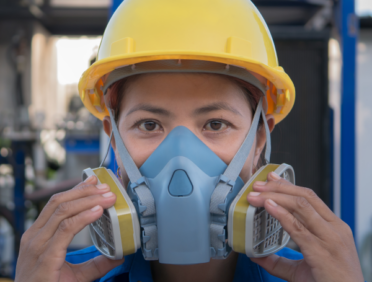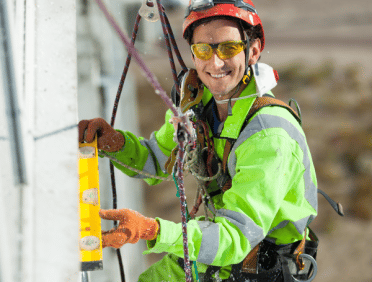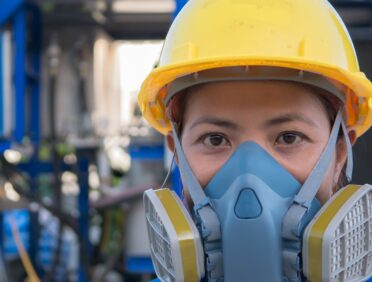What is the asbestos awareness?
Asbestos was once a material that was used in many different buildings; however, this commonplace material has since been discovered to be harmful to people. If it is within a building and is not disturbed, it does not pose a threat, however, when it is disturbed, perhaps to undergo building work or changes to a property, it can be damaged.
When it is damaged, the asbestos material will release microscopic debris which can be inhaled by a person who is exposed to it and then make its way into their airways. This can cause a variety of health issues, many of which are long-term and can even be fatal.
To be able to work around or with asbestos, you must understand what it can mean for you and how you should properly manage it.
Licensable work with asbestos
Work that is higher risk and involves asbestos should not be carried out by anyone who is not licensed to do the work. Not all asbestos work requires a license; however, it can be hard to know what is classed as licensable work with asbestos and what is not.
The Asbestos Licensing Unit (ALU) is there to ensure that there are national standards used to assess and monitor the work of licensed asbestos companies. They collect and collate all of the relevant information that has been received from site visits and assessments and then use this to build a performance history on the license holder.
This information all comes together to help them to decide on whether or not they are going to either renew an existing pass or eve issue a license to a new applicant.
Asbestos Licence Assessment And Revocation Guide (ALAARG)
It can be difficult to completely understand what is needed to apply for and keep a license to work with asbestos. The AALAARG is a guide that is designed to provide useful advice.
Whilst it is designed to be used by regulators, the AALAARG can be an interesting guide and source of information for anyone who is going to be involved in licensed asbestos work or who may need to know about the process in the future.
The licensing system
For a business to be deemed licensed to work with asbestos you are going to need to move through the licensing system. The first thing is to apply for permission (a permit) for you to carry out the higher-risk asbestos work.
To do this you will need to apply to the Asbestos Licensing Unit which will then want to see that you have the relevant skills, knowledge, expertise and competency to work with asbestos. They will also want to see evidence of your health and safety management systems so that they know that the work that is carried out is going to be as safe as possible.
To give yourself the best chance of being approved for a license, you are going to need to show:
- That you have taken the time to properly prepare
- That you are committed to improving at all times
- That you are competent
- That you understand and know the industry
- That you understand health and safety and the risks that asbestos poses to you
If you can show that you meet these requirements then there is a good chance that you will have your license approved. This will be for a set period and when this time is up, you will be required to renew it.
There is no guarantee that you will be approved or your renewal will be approved. However, regardless of the outcome you will be expected to pay a fee.
Notification of licensed work
Part of the regulations states that you must ensure that you advise the appropriate enforcing authority that you will be undertaking work that involves asbestos. This must be made at least 14 days before the work is due to commence.
This will require you to plan when you need to send this written notification to be within the laws and not have to face any issues with the work being carried out.
Notifiable Non-licensed Work (NNLW) with asbestos
Not all work that involves asbestos needs to be carried out by someone who is licensed. However, it is down to you to decide whether or not the work that you want to carry out can be identified as non-licensed work.
Some non-licensed work will be seen to be notifiable non-licensed work. This means that whilst you don’t need to have a license to carry out the work, you do need to ensure that you have the appropriate controls in place.
To meet within the NNLW requirements you are going to need to ensure that you:
- Notify work with asbestos to the enforcing authority that is relevant to you
- Ensure that you designate the areas where the work is going to be carried out
- Ensure that you carry out the relevant medical examinations
- Keep a register of the work that is carried out and the health records of those that work on it
To decide whether or not your work is NNLW you are going to need to identify the type of work that you are carrying out, the asbestos type that you will be working with and the condition of the material too.
It is always best to ensure that you are cautious with your research and decision-making. Not only because you can end up breaking rules if you do not, but also because you could be putting work health and risk.
Self employed workers
If you are someone who is self-employed and you are self-employed you are still going to need to apply for a license to ensure that you are carrying out the work safely. This will be your responsibility to apply for and you will hold the license.
This will then allow you to work on a variety of projects when asbestos is involved.
Record keeping
Whenever you work with asbestos you must ensure that you have up-to-date records that relate to the work that you have carried out. These must always be up to date.
If you have carried out work with asbestos materials then you must ensure that your records are updated. It is also important that you keep a record of the training that you and your employees have had. This could be an asbestos awareness course.
You will also want to keep a record of any asbestos materials that remain that you are responsible for. Showing that you have performed checks on them to see that they have not deteriorated over time.
Occupations that need to be aware of Asbestos Risks
There are lots of occupations that need to be aware not only of asbestos as a material but also of the risk that it poses to health. Some of these will be much more likely to come across it, however, having some knowledge is always going to be helpful no matter if your chance of having to deal with asbestos is low.
Some of the key occupations include:
- Construction Workers: Construction workers involved in demolition, renovation, or maintenance of older buildings are at a higher risk of encountering asbestos-containing materials (ACMs).
- Plumbers and Electricians: These professionals often work in buildings’ structures, where asbestos may be present in insulation or electrical components.
- HVAC Technicians: Asbestos can be found in heating, ventilation, and air conditioning systems in older buildings.
- Roofers: Asbestos-based roofing materials were commonly used in the past, putting roofers at risk of exposure.
- Insulation Installers: Asbestos was used in various forms of insulation, and workers installing or removing insulation need to be cautious.
- Painters and Decorators: Asbestos may be present in textured coatings, paints, or wallboards.
- Shipyard Workers: Many older ships and maritime structures contain asbestos.
- Firefighters: Buildings on fire may release asbestos fibres into the air, posing a risk to firefighters.
- Demolition Workers: The demolition of older buildings can lead to the release of asbestos fibres.
- Waste Management Workers: Those working at landfill sites or handling waste materials may come across asbestos-containing waste.
- Surveyors: Building surveyors need to identify and assess the presence of asbestos in properties.
- Environmental Consultants: Professionals in this field may encounter asbestos when assessing environmental risks.
- Health and Safety Inspectors: These inspectors need to ensure that proper safety measures are followed in workplaces with asbestos-containing materials.
- Asbestos Removal Contractors: Specialists who handle the safe removal and disposal of asbestos.
- Architects and Designers: Professionals involved in renovation or refurbishment projects need to be aware of the potential presence of asbestos.
- Building Maintenance Workers: Individuals involved in the repair and maintenance of older buildings may encounter asbestos-containing materials.
You can find more info below:
Architects
When designing a plan for a building, an architect may come across asbestos within the property.
Building surveyors
Building surveyors will be looking at the materials that make up the property, both inside and outside.
Computer and data installers
As much of the asbestos that is found is in loft insulation; it makes sense that those who are installing data cables and wiring will come across it in their line of work.
Construction workers
Many of the buildings that have asbestos within them in some form are commercial and therefore can be found by construction workers of all types.
Demolition workers
When buildings are demolished, there is a good chance that those who are demolishing them will come across asbestos in some form (and it will also be more likely to be damaged).
Electricians
Electricians lay cables and deal with electrics, which means that they will move roof tiles and be drilling in walls. These are all risk factors for asbestos exposure.
Fire/burglar alarm installers
Much like electricians fire alarm installers will often be found in places where asbestos can also be found.
Gas fitters
Another trade that will often be found in areas where asbestos is frequently identified is gas fitters.
General maintenance workers
Anyone who completes any form of maintenance on a property made find themselves possibly exposed to asbestos in some form.
Heating and ventilation engineers
Those who install and maintain heating and ventilation systems will be likely to find asbestos in roof and loft spaces.
Joiners
Joiners are responsible for the wood that forms the frame of a building. This puts them at risk of asbestos exposure as much of their work is within walls.
Painters and decorators
Whilst painters and decorators are amongst the last people to work on a property there are times when they are working with an old home or commercial building that they discover asbestos.
Plasterers
Much like painters and decorators a plasterer may find asbestos when working on an existing property and updating the plaster.
Plumbers
Any role that involves drilling and working in walls and ceilings, can include a risk of asbestos.
Roofers
Roofers work with the roof spaces of properties, where much of the asbestos that is used can be found.
Shop fitters
There is always a risk that a shop fitter will come across asbestos in their line of work, especially considering that commercial buildings can have asbestos in them.
Telecommunication engineers
When you work with cables and install them into a property, there is always a chance that you will come across asbestos.
Training on asbestos awareness
If you want to make sure that you are as safe as possible when you come across asbestos or you undertake work with asbestos; then the best way that you can do this is to have training on asbestos awareness.
Asbestos Awareness Certificate
If you have asbestos awareness training, then you obtain an Asbestos Awareness Certificate so that you can show that you have had the training and that you understand some of the key information that links to working with asbestos.
You can take an Asbestos Awareness course (£17.50), gain a certificate and ensure your team are compliant by clicking here.
Alternatively, you can access our money saving bundles to save over 50% by taking two or more courses.












